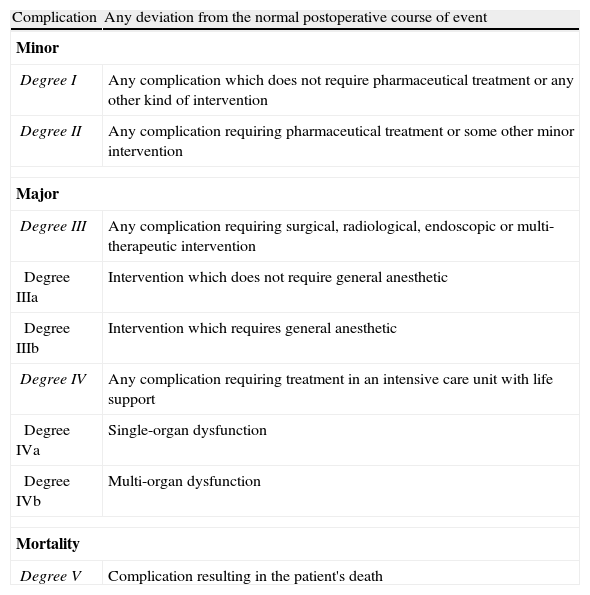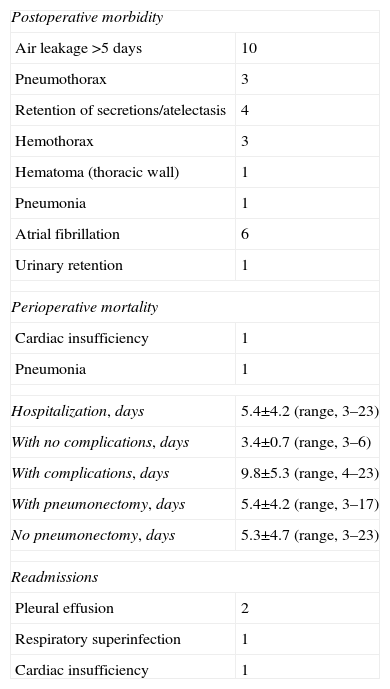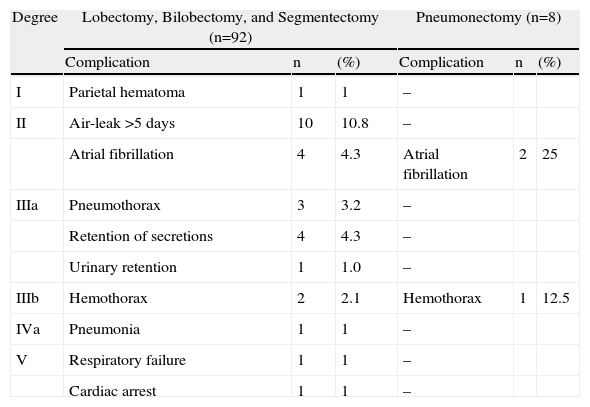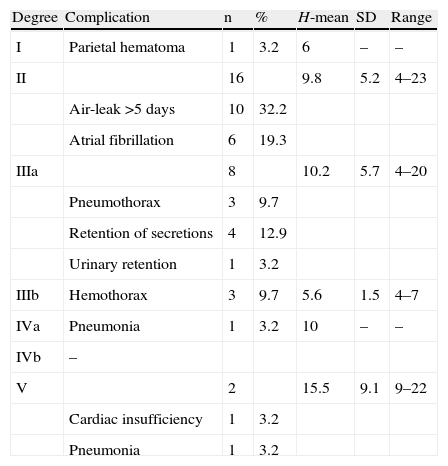This paper intends to assess the influence of a fast-track surgery program on hospital stay and morbidity/mortality in lung resection surgery.
Patients and methodsA prospective study was conducted including 100 patients who underwent open lung resection due to neoplastic pathologies. The variables analyzed were demographic, clinical, resection type, length of hospital stay, and postoperative complications, adjusting these to the classification established according to the treatment required.
ResultsSeventy-three patients were men, and mean age was 60.8. 82% of the subjects were asymptomatic, 97% had a history of smoking and the majority presented associated comorbidities. The resection types included 7 pneumonectomies, 79 lobectomies, 6 bilobectomies, and 8 segmentectomies. Mean hospital stay was 5.4±4.2 days (range, 3–23), varying between 3.4±0.8 days (range, 3–6) and 9.8±5.3 days (range, 4–23) according to the absence or presence of complications. Associated mortality was 2% and morbidity 31%; the most frequent complications were persistent air leak (10%) and atrial fibrillation (6%). 51.5% of the complications were classified within the lower grade complication group, depending on treatment required. Four patients required readmittance after hospital discharge.
ConclusionsFast-track surgery programs are able to reduce hospitalization times by planning a multidisciplinary strategy of the surgical procedure, in which the patient him/herself participates. It is equally necessary to establish systems to classify postoperative complications that can evaluate the quality of the surgery.
Este trabajo pretende evaluar la influencia de un programa de fast-track surgery en la estancia hospitalaria y en la morbimortalidad en cirugía de resección pulmonar.
Pacientes y métodosEstudio prospectivo de 100 pacientes sometidos a resección pulmonar abierta por afección neoplásica. Se analizaron las variables demográficas y las clínicas, el tipo de resección, la estancia hospitalaria y las complicaciones postoperatorias, ajustándolas a la clasificación establecida en función del tratamiento requerido.
ResultadosSetenta y tres pacientes fueron hombres y la media de edad de 60,8 años. El 82% fueron asintomáticos y el 97% tenía historia de tabaquismo. La mayoría presentó comorbilidad asociada y se realizaron 7 neumonectomías, 79 lobectomías, 6 bilobectomías y 8 segmentectomías. La estancia media fue de 5,4±4,2 días (rango, 3-23), variando entre 3,4±0.8 días (rango, 3-6) y de 9,8±5,3 días (rango, 4-23) en función de la ausencia o presencia de complicaciones. La mortalidad asociada fue del 2% y la morbilidad del 31%, siendo las complicaciones más frecuentes la fuga aérea persistente (10%) y la fibrilación auricular (6%). El 51,5% de las complicaciones se clasificaron dentro del grupo de complicaciones de menor grado en función del tratamiento requerido. Cuatro pacientes requirieron reingreso tras el alta hospitalaria.
ConclusionesLos programas de fast-track surgery permiten conseguir una reducción de los tiempos de estancia hospitalaria al planificar una estrategia multidisciplinar del procedimiento quirúrgico, en el que toma parte activa el propio paciente. Igualmente, se hace necesario establecer sistemas de clasificación de las complicaciones postoperatorias que puedan evaluar la calidad de la cirugía.
Post-operative complications, especially in the case of pulmonary surgery, remain a common problem in pulmonary resection, which might well entail a prolonged post-operative stay in hospital, with the consequent discomfort for the patient and economic impact. The length of hospitalization required for pulmonary resection is determined by 3 factors: air leakage, pain management, and complications.
Fast track surgery is a multidisciplinary strategy which involves a combination of educating the patient before surgery, post-operative stress management by means of new anesthetic, analgesic and pharmaceutical techniques, minimally invasive surgery, aggressive post-operative rehabilitation, and a review of the classical principles of postoperative assistance (drip-feeding, drainage, catheters etc.), with a view to bringing about the rapid recovery of the patient and, consequently, reducing the length of hospitalization.1
In our country the average period of hospitalization for major open thoracic procedures is 8.2 days, which is prolonged to 11.4 days when complications arise.2 The use of fast track programs in thoracic surgery can achieve a substantial reduction in post-operative morbidity and mortality,3–6 even with high risk patients,7 with the consequent implications in terms of the length of hospitalization.
Objective analysis and discussion concerning post-operative morbidity and mortality are indispensable when it comes to evaluating the quality of health care. However, defining and measuring quality is no easy task.8 Recently, Seely et al.9 introduced a novel system to measure the degree of complications in proportion to the effort required to deal with them, on the basis of the Clavien–Dindo scheme.10,11
The aim of our study is to determine the length of hospitalization of a series of patients on whom major open pulmonary resections had been performed, and who had been included in a fast-track program, with an analysis of the postoperative morbimortality rate from the point of view of the classification proposed by Seely et al.9
Materials and MethodsStudy PopulationThe study included, both consecutively and prospectively, 100 patients on whom anatomical pulmonary resections had been performed for neoplastic disease: pneumonectomy, lobectomy, bilobectomy or segmentectomy, wedge resections having been ruled out. All the interventions were programmed by the same group of surgeons from the Thoracic Surgery Department of the Fundación Instituto Valenciano de Oncología, between November 2008 and July 2011.
ProtocolPreoperative- –
The patient was informed with particular emphasis being placed on the importance of his or her active participation in the process.
- –
Preoperative respiratory physiotherapy.
- –
Antibiotic prophylaxis.
- –
Antirobotic prophylaxis.
- –
Anesthetic protocol: insertion of epidural catheter (level T6–T7).
- –
Adjusted hydration: replacement of blood loss and imperceptible loss at the rate of 6–8ml/kg/h.
- –
Thermal blanket and drip administration at a controlled temperature.
- –
The use of metal auto-suture devices for the separation of pulmonary incisions.
- –
Removal of tracheal intubation in the operating theatre.
- –
The initiation of postoperative analgesic treatment before concluding the intervention.
- –
Multimodal postoperative analgesic: epidural catheter with local anesthetics in continued perfusion during 48h and intravenous analgesic alternating between non-steroid anti-inflammatories and paracetamol every 4h.
- –
Initiation of oral ingestion tolerance after between 4 and 6h.
- –
Removal of drip-feed when oral tolerance is reached.
- –
Respiratory physiotherapy and mobilization during the first 24h.
- –
Removal of the thoracic drains after 48h provided there has been no air leakage.
- –
Radiological monitoring with expanded lung
- –
Correct cardio-respiratory function
- –
Pain control via oral analgesic
- –
Adequate patient mobility
The following variables were collected for each of the patients: sex, age, presence or absence of symptoms, smoking habit, associated comorbidity, primary neoplastic disease or metastasis, forced vital capacity (FVC), peak expiratory volume in the first second (FEV1), FEV1/FVC ratio, carbon monoxide diffusing capacity (DLCO), American Society Anestesiologist (ASA) morbid-mortality risk index, extent of the pulmonary resection, air-leakage >5 days, perioperative morbimortality; in the latter case the classification applied for complications in relation to the treatment required was the one published by Seely et al. (Table 1), hospitalization and readmission.
| Complication | Any deviation from the normal postoperative course of event |
| Minor | |
| Degree I | Any complication which does not require pharmaceutical treatment or any other kind of intervention |
| Degree II | Any complication requiring pharmaceutical treatment or some other minor intervention |
| Major | |
| Degree III | Any complication requiring surgical, radiological, endoscopic or multi-therapeutic intervention |
| Degree IIIa | Intervention which does not require general anesthetic |
| Degree IIIb | Intervention which requires general anesthetic |
| Degree IV | Any complication requiring treatment in an intensive care unit with life support |
| Degree IVa | Single-organ dysfunction |
| Degree IVb | Multi-organ dysfunction |
| Mortality | |
| Degree V | Complication resulting in the patient's death |
A descriptive analysis of the series being studied was carried out. For the quantitative variables statistical calculations were made for centralization, mean and median, and of dispersion, standard and range deviation. For the categorical variables the absolute frequency and the percentage were calculated.
ResultsIn our study, 73 patients were men and 27 were women. The average age was 60.8±8.9 years (range, 38–80). Only 18% presented symptoms, of which bloody sputum was the most common. As regards antecedents, 97% had a history of smoking, with an average of 45.8±29.5 years/packet (range, 0–180), and 67% were still active smokers. As for associated comorbidities, high blood-pressure, chronic obstructive pulmonary disease and the presence of neoplastic antecedents were the most frequent, with a clear link to tobacco smoking. In 94 cases the tumor was primary and only in 6 cases it was a metastasis. In the case of primary neoplastic disease, 30 patients had had neoplasia in other locations, especially in the urological and otorhinolaryngological areas. The FVC average was 84.7%±14.7%, the FEV1 average was 82.5%±15.4% the FEV1/FVC ratio was 0.74±0.11. The DLCO average was 77.8%±19.7%. Thirty patients were classified as ASA 2, 68 as ASA 3, and 2 as ASA 4. The surgery performed consisted of 8 pneumonectomies, 80 lobectomies, 4 bilobectomies, and 8 segmentectomies. Table 2 shows the clinical-demographic characteristics of the whole series.
Demographic-Clinical Characteristics.
| Sex | |
| Male | 73 |
| Female | 27 |
| Age, years | 60.8±8.9 (range, 38–80) |
| Symptoms | |
| Asymptomatic | 82 |
| Symptomatic | 18 |
| Bloody sputum | 10 |
| Persistent coughing | 6 |
| Pneumothorax | 1 |
| Constitutional syndrome | 1 |
| Smoking habit, years packet | 46±30 (range, 0–180) |
| Active smokers | 67 |
| Comorbidity | |
| Dyslipidemia | 27 |
| Diabetes 13 mellitus | 11 |
| High blood-pressure | 33 |
| Cardiac disease | 11 |
| Vascular disease | 13 |
| COPD | 29 |
| Hepatic illness | 3 |
| Renal illness | 1 |
| Neoadjuvant therapy | 9 |
| Previous neoplastic condition | 30 |
| ORL | 8 |
| Urological | 11 |
| Breast | 5 |
| Gynecological | 1 |
| Lymphatic | 2 |
| SNC | 1 |
| Digestive | 1 |
| Skin | 1 |
| Respiratory function evaluation | |
| FVC, % | 84.7±14.7 |
| FEV1, % | 82.5±15.4 |
| FEV1/FVC | 0.74±0.11 |
| DLCO, % | 77.8±11.7 |
| ASA | |
| 2 | 30 |
| 3 | 68 |
| 4 | 2 |
| Extent of exeresis | |
| Segmentectomy | 8 |
| Lobectomy | 80 |
| Bilobectomy | 4 |
| Pneumonectomy | 8 |
31% of the patients had post-operative complications, and 10 patients presented air leakage >5 days. In 3 patients there was evidence of pneumothorax following the removal of the thoracic drains, which meant that a new drain had to be applied. On 4 occasions it was necessary to carry out an endobronchial aspiration by means of a fibrobronchoscope due to the retention of secretions/atectectasis. Three patients suffered a hemothorax, which required thoracotomy. Finally, 1 patient was diagnosed with pneumonia, which required readmission to the reanimation unit and another presented a hematoma at the level of the thoracotomy which did not require treatment. As regards the non-respiratory complications, 6 patients presented atrial fibrillation which could be controlled by sole recourse to medical treatments, and one had a urinary retention for which a urinary catheter had to be fitted in 6 days. Perioperative mortality was 2%, 1 patient as a result of cardiac insufficiency, and another due to pneumonia (Table 3).
Postoperative Morbimortality. Length of Stay. Readmissions.
| Postoperative morbidity | |
| Air leakage >5 days | 10 |
| Pneumothorax | 3 |
| Retention of secretions/atelectasis | 4 |
| Hemothorax | 3 |
| Hematoma (thoracic wall) | 1 |
| Pneumonia | 1 |
| Atrial fibrillation | 6 |
| Urinary retention | 1 |
| Perioperative mortality | |
| Cardiac insufficiency | 1 |
| Pneumonia | 1 |
| Hospitalization, days | 5.4±4.2 (range, 3–23) |
| With no complications, days | 3.4±0.7 (range, 3–6) |
| With complications, days | 9.8±5.3 (range, 4–23) |
| With pneumonectomy, days | 5.4±4.2 (range, 3–17) |
| No pneumonectomy, days | 5.3±4.7 (range, 3–23) |
| Readmissions | |
| Pleural effusion | 2 |
| Respiratory superinfection | 1 |
| Cardiac insufficiency | 1 |
The mean total period of hospitalization was 5.4±4.2 days (range, 3–23), the average being 4 days. When there were no complications, the mean hospitalization period was 3.4±0.8 days (range, 3–6) and when complications occurred it was 9.8±5.3 days (range, 4–23). In the case of pneumonectomy it was 5.4±4.2 days (range, 3–17) and of pulmonary resection 5.3±4.7 days (3–23). Readmission was necessary for 4 patients: two for pleural effusion which required a thoracic drain, one of respiratory superinfection and another for cardiac insufficiency. None of these patients had presented any complication during the postoperative stage (Table 3).
As regards the classification of the complications as proposed by Seely et al.,9 they are shown in Table 4. The most frequent (51.5%) of these complications were of minor importance, especially air leakage >5 days. The complications by degree of importance and the corresponding period of hospitalization required are shown in Table 5.
Complications by Degrees and Surgical Procedures.
| Degree | Lobectomy, Bilobectomy, and Segmentectomy (n=92) | Pneumonectomy (n=8) | ||||
| Complication | n | (%) | Complication | n | (%) | |
| I | Parietal hematoma | 1 | 1 | – | ||
| II | Air-leak >5 days | 10 | 10.8 | – | ||
| Atrial fibrillation | 4 | 4.3 | Atrial fibrillation | 2 | 25 | |
| IIIa | Pneumothorax | 3 | 3.2 | – | ||
| Retention of secretions | 4 | 4.3 | – | |||
| Urinary retention | 1 | 1.0 | – | |||
| IIIb | Hemothorax | 2 | 2.1 | Hemothorax | 1 | 12.5 |
| IVa | Pneumonia | 1 | 1 | – | ||
| V | Respiratory failure | 1 | 1 | – | ||
| Cardiac arrest | 1 | 1 | – | |||
Complications by Degrees and Length of Hospitalization.
| Degree | Complication | n | % | H-mean | SD | Range |
| I | Parietal hematoma | 1 | 3.2 | 6 | – | – |
| II | 16 | 9.8 | 5.2 | 4–23 | ||
| Air-leak >5 days | 10 | 32.2 | ||||
| Atrial fibrillation | 6 | 19.3 | ||||
| IIIa | 8 | 10.2 | 5.7 | 4–20 | ||
| Pneumothorax | 3 | 9.7 | ||||
| Retention of secretions | 4 | 12.9 | ||||
| Urinary retention | 1 | 3.2 | ||||
| IIIb | Hemothorax | 3 | 9.7 | 5.6 | 1.5 | 4–7 |
| IVa | Pneumonia | 1 | 3.2 | 10 | – | – |
| IVb | – | |||||
| V | 2 | 15.5 | 9.1 | 9–22 | ||
| Cardiac insufficiency | 1 | 3.2 | ||||
| Pneumonia | 1 | 3.2 |
H, hospitalization; SD, standard deviation.
In our experience, the introduction of a fast-track program for a group of patients on whom open pulmonary resections have been performed has significantly reduced the period of hospitalization with respect to the average period for major open thoracic procedures in pulmonology units,2 which has important implications both for the rapid recovery of the patient and for the sustainability of the health service.
By contrast with other surgical specialties such as digestive surgery, there are few studies which support the concept of fast-track programs in thoracic surgery.12 A recent randomized prospective study has highlighted the significant reduction in the rates of postoperative complications in patients enrolled on a fast-track program, even though, paradoxically, the results indicate no impact whatsoever in terms of the length of hospitalization, which was 11 days.5 On the other hand, the mean and median length of hospitalization in our study, 5.4 and 4 days respectively, can be extrapolated to the results published by other authors.3,4
It is essential to be aware of the morbidity and mortality that surgery entails when evaluating its quality. However, it is extremely difficult to define and evaluate quality, so appropriate standards and criteria must be formulated which will enable us to obtain the necessary information.8 While it is true that operative mortality is by and large a robust statistic, as it is reflected in medical literature and can easily be compared, this is not the case with morbidity rates, as different criteria are applied in classification, which makes it difficult to establish comparisons between the activities of different working groups.The 2% mortality rate observed in our series, as well as the 31% morbidity rate, was within the range of observed in patients subjected to lobectomy and included in the fast-track surgery program, in which air leakage and atrial fibrillation were the most frequent complications encountered.3–6
The lack of consensus when it comes to defining and evaluating adverse operative events has obstructed the analysis of the quality of surgical procedures. Undoubtedly, the introduction of a new system of classification of the complications in proportion to the severity of the treatment required, the so-called Clavien–Dindo system,10,11 could be an important step toward establishing a common language for the different working groups, and a useful tool for evaluating the quality of surgery. Recently Seely et al. have incorporated the said system for the classification of complications into their work on thoracic surgery.9
In this latter study, 49.3% of the patients on whom a lobectomy was performed presented complications, while the rate was 54.6% for pneumonectomies. In our series the complications in the case of lobectomy amounted to 30.4%, while for pneumonectomy the rate was 37.5%, probably as a result of the implementation of a fast-track program. As for the classification in terms of degrees, the incidence was 7.5%, 69.6%, 16.1%, and 4.9% of the total number of complications for grades I, II, III, and IV respectively. In our experience, the complications pertaining to group II were also the most frequent, albeit with a somewhat lower incidence (50%), as the most frequently observed complications in our study were air leakage >5 days and atrial fibrillation. In group II ate presence of pneumothorax with the consequent need to fit a drainage system was the most frequent complication observed by Seely et al.,9 while in our series it was the need for bronchoaspiration and fibrobronchoscopy for retention of secretions/atelectasis. A far as the other groups were concerned, we have found no differences, as was also the case for postoperative mortality (degree V), which was 2.2%. Likewise, the appearance of complications had significant implications for the length of hospitalization, although in our case the rate of readmission was lower, 4%, and none of the patients who were readmitted had had previous postoperative complications.
By way of conclusion, the introduction of a fast-track surgery program for pulmonary resection has a significant impact on the duration of hospitalization, and the application of systems for the classification of postoperative complications could be worthwhile with a view to evaluating the quality of surgery.
Conflicts of InterestThe authors have no conflicts of interest to declare.
Please cite this article as: Padilla Alarcón J, Peñalver Cuesta JC. Experiencia de un programa de fast-track surgery en resección pulmonar. Arch Bronconeumol. 2013;49:89–93.














